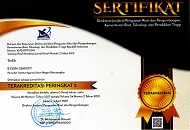PEMBELAJARAN ENGLISH PUBLIC SPEAKING BERBASIS PROJECT-BASED LEARNING
Abstract
Keywords
Full Text:
PDF (Indonesia)References
Ferreira Marinho, A. C., Mesquita de Medeiros, A., Côrtes Gama, A. C., & Caldas Teixeira, L. (2017). Fear of Public Speaking: Perception of College Students and Correlates. Journal of Voice, 31(1), 127.e7–127.e11. doi:10.1016/j.jvoice.2015.12.012
Furmark, T. (2002). Social phobia: overview of community surveys. Acta Psychiatrica
Goberman, A. M., Hughes, S., & Haydock, T. (2011). Acoustic characteristics of public speaking: Anxiety and practice effects. Speech Communication, 53(6), 867–876. doi:10.1016/j.specom.2011.02.005
Hancock, A. B., Stone, M. D., Brundage, S. B., & Zeigler, M. T. (2010). Public Speaking Attitudes: Does Curriculum Make a Difference? Journal of Voice, 24(3), 302–307. doi:10.1016/j.jvoice.2008.09.007.
Lee, Yow-jyy Joyce and Liang, Jung-Chin. 2012 Using Video Technology to Diagnose EFL Students’ Cognitive Learning Difficulties in Public Speaking.
McLeod, S. A. (2017). Kolb - learning styles. Retrieved from https://www.simplypsychology.org/learning-kolb.html.
Prince, M. And Felder, R.M. (2016). Inductive Teaching and Learning Methods: Definitions, Comparisons, and Research Bases. Journal of Engineering Education, Vol. 95, No. 2, pp.123–138.
Shi, X., Brinthaupt, T. M., & McCree, M. (2015). The relationship of self-talk frequency to communication apprehension and public speaking anxiety. Personality and Individual Differences, 75, 125–129. doi:10.1016/j.paid.2014.11.023.
DOI: http://dx.doi.org/10.31958/jt.v21i2.1235
Refbacks
- There are currently no refbacks.
Copyright (c) 2018 Ta'dib

This work is licensed under a Creative Commons Attribution-NonCommercial-NoDerivatives 4.0 International License.
TA'DIB with registered number e-ISSN: 2580-2771, p-ISSN: 1410-8208 have been indexed on:

Journal Ta'dib distribute under Lisensi Creative Commons Atribusi-NonKomersial 4.0 Internasional.
Contact us: Ta'dib; Address: FTIK, Universitas Islam Negeri Mahmud Yunus Batusangkar; Jl. Sudirman No. 137 Lima Kaum Batusangkar, Tanah Datar, Sumatera Barat, Indonesia. Email: takdib@uinmybatusangkar.ac.id

























